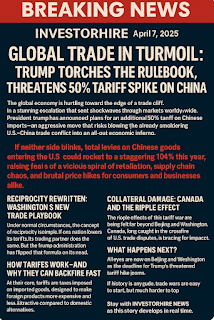🚨 InvestorHire News | April 7, 2025 — BREAKING
Global Trade in Turmoil: Trump Torches the Rulebook, Threatens 50% Tariff Spike on China
The global economy is hurtling toward the edge of a trade cliff.
In a stunning escalation that sent shockwaves through markets worldwide, President Trump has announced plans for an additional 50% tariff on Chinese imports—an aggressive move that risks blowing the already smoldering U.S.–China trade conflict into an all-out economic inferno.
Beijing, in a fiery rebuke, slammed the decision as “blackmail,” vowing to "fight to the end" if Washington proceeds. If neither side blinks, total levies on Chinese goods entering the U.S. could rocket to a staggering 104% this year, raising fears of a vicious spiral of retaliation, supply chain chaos, and brutal price hikes for consumers and businesses alike.
Wall Street is already feeling the tremors, with indexes flashing red amid fears of a full-blown trade war reminiscent of the pandemic-era market freefall.
But here’s the twist:
This showdown isn’t just about China. It’s about a radical reimagining of the rules that have governed global trade for decades.
🔎 Reciprocity Rewritten: Washington’s New Trade Playbook
Under normal circumstances, the concept of reciprocity is simple: if one nation lowers its tariffs, its trading partner does the same. But the Trump administration has flipped that formula on its head.
Even as nations like Vietnam and the European Union step forward with offers to reduce tariffs on U.S. goods, the White House is refusing to return the favor. Instead, it’s digging in, deploying an aggressive strategy aimed at forcing deep structural changes in global trade flows.
White House trade advisor Peter Navarro, speaking on CNBC’s Squawk Box, justified the hardline stance by accusing Vietnam of "nontariff cheating"—citing practices like Chinese goods being rerouted through Vietnam to dodge tariffs, and persistent intellectual property theft.
This marks a pivotal shift: tariffs are no longer just blunt instruments to correct trade deficits (a measure many economists already call misleading). Under Trump’s vision, they’ve become weapons to reshape global manufacturing routes and rewrite the flow of commerce itself.
🌎 Collateral Damage: Canada and the Ripple Effect
The ripple effects of this tariff war are being felt far beyond Beijing and Washington.
Canada, long caught in the crossfire of U.S. trade disputes, is bracing for impact. Canadian exporters remember well the bruising tariff battles of recent years—particularly in steel, aluminum, and agriculture—where retaliatory tariffs from both sides hammered businesses and forced complex trade workarounds.
For Canadians, this latest escalation is a grim reminder that in trade wars, no country is truly a bystander. Higher U.S. tariffs on China could reroute Chinese exports toward Canadian markets, flooding sectors like manufacturing and raw materials. Simultaneously, Canadian producers could find themselves squeezed between rising costs and limited access to U.S. consumers.
⚙️ How Tariffs Work—And Why They Can Backfire Fast
At their core, tariffs are taxes imposed on imported goods, designed to make foreign products more expensive and less attractive compared to domestic alternatives. In theory, this protects local industries from unfair competition.
But in practice?
It’s a dangerous game of economic tit-for-tat.
When Country A slaps tariffs on Country B, retaliation almost always follows. Supply chains seize up. Prices climb. Businesses scramble to adapt, and consumers pay the price at the checkout counter. Add to that the complexity of today’s globally interconnected economy, and a localized tariff decision can spark global disruptions.
With Trump’s latest salvo, we’re witnessing not just a trade disagreement—but an all-out battle over the future of global commerce.
📊 What Happens Next?
All eyes are now on Beijing and Washington as the deadline for Trump’s threatened tariff hike looms. Diplomats are scrambling behind the scenes, but public rhetoric on both sides suggests little appetite for compromise.
Investors, meanwhile, are buckling up for turbulence.
If history is any guide, trade wars are easy to start, but much harder to stop. And in this high-stakes showdown, the costs of escalation could ripple across every corner of the global economy—hitting supply chains, inflation rates, and investor confidence at a time when stability is desperately needed.
Stay with InvestorHire News as this story develops in real time.





No comments:
Post a Comment